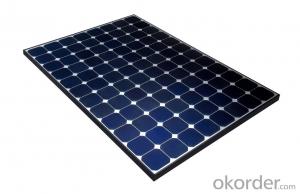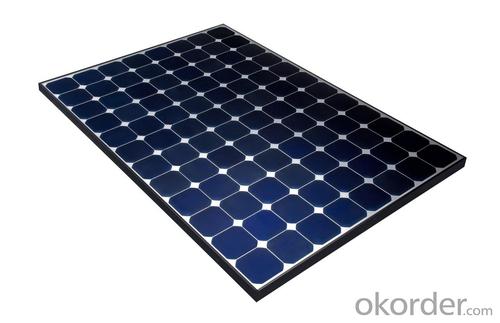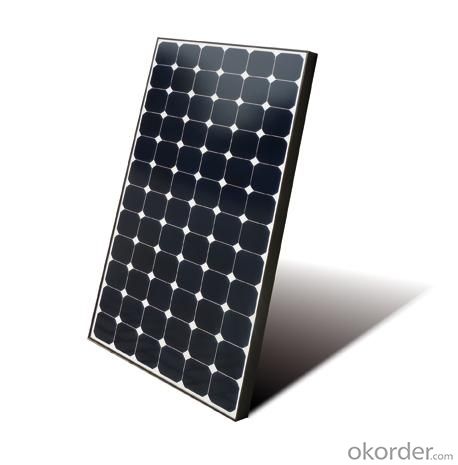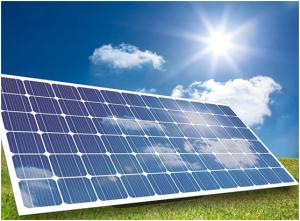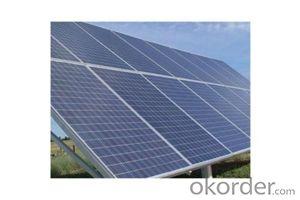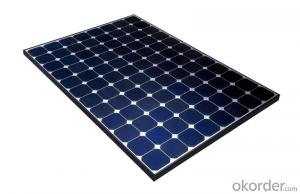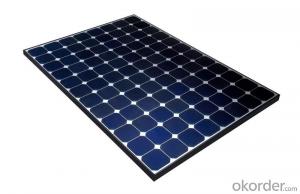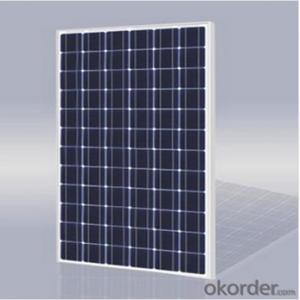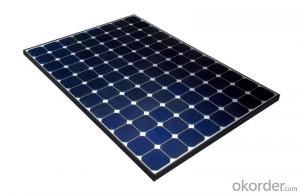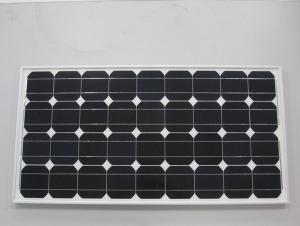12 Volt CNBM Poly 200W Solar Panel with TUV UL CE Certificate for Residential
- Loading Port:
- Shanghai
- Payment Terms:
- TT OR LC
- Min Order Qty:
- 100 watt
- Supply Capability:
- 1000 watt/month
OKorder Service Pledge
OKorder Financial Service
You Might Also Like
Specification
CNBM Poly 200W Solar Panel with TUV UL CE Certificate For Residential
Introduction
Each module is rated by its DC output power under standard test conditions, and typically ranges from 100 to 365 watts. The efficiency of a module determines the area of a module given the same rated output – an 8% efficient 230 watt module will have twice the area of a 16% efficient 230 watt module. There are a few solar panels available that are exceeding 19% efficiency. A single solar module can produce only a limited amount of power; most installations contain multiple modules. A photovoltaic system typically includes a panel or an array of solar modules, a solar inverter, and sometimes a battery and/or solar tracker and interconnection wiring.
Solar modules use light energy (photons) from the sun to generate electricity through the photovoltaic effect. The majority of modules use wafer-based crystalline silicon cells or thin-film cells based on cadmium telluride or silicon. The structural (load carrying) member of a module can either be the top layer or the back layer. Cells must also be protected from mechanical damage and moisture. Most solar modules are rigid, but semi-flexible ones are available, based on thin-film cells.
Micro-inverted solar panels are wired in parallel which produces more output than normal panels which are wired in series with the output of the series determined by the lowest performing panel (this is known as the "Christmas light effect"). Micro-inverters work independently so each panel contributes its maximum possible output given the available sunlight.[6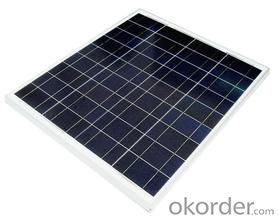
Suggested application
Home lighting business lighting,
Garden lighting, pavement lighting
Farmer household lighting
Decorative water pump
Traffic signal lighting
Industry area
Business area
Solar Power Plant
Product feature
Modules are made of Monocrystalline or Polycrystalline Silicon cell.
Materials and color of the solar panel frame: Clear anodized aluminum alloy type 6063T5 Universal frame; Silver-white color;
The output connection gathers the coupling: Selects conforms to the IEC-612615; 2005, class II, IEC61730 international standard; Airtight waterproofing binding clamp;
Module seal structure: The surface is thick, the high diaphanous rate armored glass with solar cell board special-purpose 3.2mm becomes after the high temperature lamination craft. The back selects has waterproof and anti- aged performance fine TPT materials. The entire block battery board has, the waterproofing, the anti- aging airtight and so on the fine performance;
Power tolerance: +/-3%
Packaging
International standard cartons (according to the requirements of customers)
- Q: Are solar panels durable?
- Yes, solar panels are generally durable. They are designed to withstand harsh weather conditions, such as rain, snow, and wind. Additionally, they have a long lifespan, typically ranging from 25 to 30 years. However, the durability may vary depending on the quality of the panels and the installation process.
- Q: Hi! I bought a Coleman 2 vdc cooler that pulls 9 amps. What size solar panel and amp-hour battery do I need? I only open it 3 times a day. It will hold about 3 gals of milk.
- If it pulls 9 amps continuously, that's 08 watts/hour or about 2.5 kwh/day. If it only pulls half that (does it cycle?) it's about .2 kwh/day. You only want to drain a lead-acid battery 50% or so, so you'll want a 5 or 2.5 kwh battery pack. A typical setup for the 5 kwh would be two L-6 batteries in series, and for the 2.5 kwh you could use 2 T-05 batteries in series. This does not account for days of cloud. If you regularly have cloudy days, size the battery pack for two or three days of use with no input (2-3 x the sizes given above). To charge them, you typically want panels that will charge your battery at least 5% of its capacity per hour (C/20). For 2 volt nominal panels that's 0 amps for the T-05 or 20 amps for the L-6 batteries. It's good to have more than that for battery life (it cuts down on what's called stratification), so you'll want probably 50-200 watts of panels for the T-05 and 300-400 for the L-6. You'll also need a charge controller. Peltier coolers are very inefficient. You'll save money by using a regular mini-fridge and an inverter. Most mini-fridges only draw 50 watts or so, so you're talking 600 watt-hours for a 50% duty cycle. This means two T-05 batteries will give you two days of use and you'll only need 20-50 watts of panel. DK
- Q: Can solar panels be used in areas with high levels of hurricanes?
- Yes, solar panels can be used in areas with high levels of hurricanes. However, it is crucial to ensure that the solar panel installation is designed and built to withstand strong winds and other extreme weather conditions. This can be achieved through proper engineering, using sturdy mounting systems, and adhering to local building codes and regulations.
- Q: Can solar panels be used in areas with high levels of chemical pollutants?
- Yes, solar panels can be used in areas with high levels of chemical pollutants. While chemical pollutants in the air or water may affect the efficiency or performance of solar panels to some extent, they are still capable of generating electricity in such areas. However, regular cleaning and maintenance of the panels may be required to ensure optimal performance and longevity in polluted environments.
- Q: How much space do I need for solar panels?
- The amount of space needed for solar panels varies depending on the size and capacity of the panels. On average, a typical residential solar panel system requires about 100-400 square feet of roof space, but it can also be installed in a backyard or ground-mounted depending on available space. It is best to consult with a solar installation professional who can assess your specific needs and determine the exact space requirements for your solar panels.
- Q: Can solar panels be installed on factories or manufacturing facilities?
- Yes, solar panels can be installed on factories or manufacturing facilities. In fact, many industrial buildings are ideal for solar panel installations due to their large roof space and high energy consumption. Installing solar panels on such facilities can help reduce electricity costs, decrease reliance on traditional energy sources, and contribute to a more sustainable and environmentally friendly operation.
- Q: Can solar panels be installed on a government building or facility?
- Yes, solar panels can be installed on a government building or facility. In fact, many government entities have already started incorporating solar energy as a sustainable and cost-effective solution to meet their energy needs. Solar panels not only help reduce carbon emissions but also provide long-term savings on electricity bills.
- Q: How can I calculate the amount of watts needed for a solar panel to power a water and air pump in gal/hr and a 600 watt LED light?
- With you up to solar panel, then things go downhill. Your Water pump will be rated at gal/hr but how about the air pump? 600watt LED? What you need to know in order to select your solar panel is how much current you will be draining. You can work this out if you know how much power and how long they need to run. Please, a bit more information (that is relevant!).
- Q: My solar panel is 24long..It is set at 45deg..the arms are 8quot;long to achieve that angle for winter. I need to get to 7deg for summer..how long will the new arms need to be?..in layman's terms please...thx
- You did not give the details of how the legs are attached to the panel. I did some calculations on my right triangle analysis application. Based on an assumption that the legs are vertical and attached to the bottom of the panel top, i calculated the legs must be 6.97 inches long. This compares favorably with the 8 inches you quoted. t If my assumption is true, the leg length for a 7 degree angle is 2.925 inches. The configuration, if my assumption is correct, will be a right triangle. The hypotenuse (longest leg of the triangle) is the panel length and the vertical legs are the supports. If my assumption is incorrect, edit your question to detail the support /panel configuration. TexMav
- Q: Can solar panels be used in areas with frequent lightning storms?
- Yes, solar panels can be used in areas with frequent lightning storms. However, it is recommended to take certain precautions to minimize the risk of damage. These precautions include installing surge protection devices, grounding systems, and lightning arrestors to divert the lightning strike's energy away from the solar panels. Additionally, using high-quality equipment that meets safety standards can also help mitigate potential damage caused by lightning strikes.
Send your message to us
12 Volt CNBM Poly 200W Solar Panel with TUV UL CE Certificate for Residential
- Loading Port:
- Shanghai
- Payment Terms:
- TT OR LC
- Min Order Qty:
- 100 watt
- Supply Capability:
- 1000 watt/month
OKorder Service Pledge
OKorder Financial Service
Similar products
Hot products
Hot Searches
